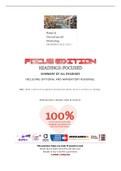SUMMARY OF ALL READINGS
INCLUDING OPTIONAL AND MANDATORY READINGS .
Note: Week 3 and 6 are Assignment presentation weeks, hence no lectures or readings.
E n h a n c e d w i t h a d y n a m ic t a b le o f c o n t e n t s .
, MADS MADLAD |2
Note from MADS MADLAD:
Thank you for buying my summary. I sincerely hope it helps you excel and learn
from this course. When I was writing these I sometimes struggled with this
program, but there were no summaries available.
This is why I decided to write something that is truly complete with a lot of
effort put into it. It helped me and my friends get good grades, but I also
always had you in mind, the future reader. When necessary, I always went the
extra mile to make this summary, more readable, organized and complete.
If you feel like it, leave me a review of how the course is going using this
summary, it will make my day to hear your opinion good or bad!
Check out my other extensive summaries for other MADS courses:
Available on:
Contact info:
If you need help or have an inquiry, contact me: https://www.georgedreemer.com
Connect with me on LinkedIn: https://www.linkedin.com/in/georgedreemer/
Donations:
By no means am I looking for fellow students to send me money! But if you feel like sending
me some ETH or BTC, you can do so here:
--> ETH: 0x123e086c6808459e7fC6Ac7F64a77dBA1dDe0149
--> BTC: bc1qgwzc82vph5v8rmzef4ywechjf85772n7m2e22g
, MADS MADLAD |3
wishes you good luck & perseverance.
Grades Testimony:
, MADS MADLAD |4
Table of Contents
Week 1............................................................................................................... 6
Reading 1: Loyalty Formation for Different Customer Journey Segments ....... 6
Reading 2: Online and offline retailing ............................................................ 9
Reading 3: The impact of digital transformation on the retailing value chain
..................................................................................................................... 11
Reading 4: Towards the identification of customer experience touch point
elements ....................................................................................................... 14
Week 2............................................................................................................. 17
Reading 5: Hedonic shopping motivations .................................................... 17
Reading 6: Shopper-Facing Retail Technology............................................... 20
Reading 7: The Interplay Among Category Characteristics, Customer
Characteristics, and Customer Activities on In-Store Decision Making.......... 24
Week 4............................................................................................................. 29
Reading 8 – Assortment: Consumers’ Perceptions of the Assortment Offered
in a Grocery Category: The Impact of Item Reduction .................................. 29
Abstract / Key Takeaway (in-short) ............................................................ 29
Reading 9 – Assortment: How does assortment affect grocery store choice?
..................................................................................................................... 31
Abstract / Key Takeaway (in-short) ............................................................ 31
Key Takeaways (in-depth) .......................................................................... 31
Reading (not for exam) – Useful for Assignment 2 on assortment: How Many
Versions of a Product Do Consumers Really Want? ...................................... 33
Key Findings: .............................................................................................. 33
Reading (not for exam) – Useful for Assignment 2 on assortment: Which
products should you stock? .......................................................................... 34
Key Findings: .............................................................................................. 34
Week 5............................................................................................................. 35
Reading 10 – Promotion: Is 75% of the Sales Promotion Bump Due to Brand
Switching? No, only 33% Is ........................................................................... 35
Abstract / Key Takeaway (in-short) ............................................................ 35
, MADS MADLAD |5
Key Takeaways (in-depth) .......................................................................... 35
Reading 11 – Price: New Empirical Generalizations on the Determinants of
Price Elasticity ............................................................................................... 36
Abstract / Key Takeaway (in-short) ............................................................ 36
Key Takeaways (in-depth) .......................................................................... 36
Reading 12 – The Good-Better-Best Approach to Pricing .............................. 40
Week 7............................................................................................................. 44
, MADS MADLAD |6
Week 1
Reading 1: Loyalty Formation for Different Customer Journey Segments
Herhausen, D., Kleinlercher, K., Verhoef, P. C., Emrich, O., & Rudolph, T. (2019). Loyalty formation for
different customer journey segments. Journal of Retailing, 95(3), 9-29.
Customer Journey segments are homogenous groups of customer with a similar
touchpoint usage during the customer journey.
Definitions from article:
• Customer journey is the customer’s search and purchase usage of all
online and offline touchpoints from various sources, including retailer-
owned, competitor-owned, and additional touchpoints.
• One of the major goals of customer experience management is to design
journeys that induce short-term sales and long-term customer loyalty.
(Homburg, Jozic, and Kuehnl, 2017)
• Customer loyalty is a customer’s intention to engage again in a journey of
touchpoints provided by a given retailer and to transit from post-purchase
to repurchase at this retailer. (Homburg et al., 2017; Court et al., 2009)
• Customer loyalty is formed through customer experience encompassing
three components:
o Product satisfaction: the evaluation of the purchased product as an
outcome of the journey.
o Journey satisfaction: customers’ processing of stimuli encountered
during the journey, leading to global affective evaluation of it.
▪ Associated with consistent experience across touchpoints
o Customer inspiration: customer’s cognitive transformation of
stimuli encountered during the journey, leading to new cognitive
insights.
▪ Based on sensations of novelty
, MADS MADLAD |7
• Insights on Mobile Devices:
o Mobile usage is becoming more important in today’s customer
journeys (Verhoef et al. 2017).
o Moving from a mobile device to a desktop increases conversion (de
Haan et al., 2018; Xu et al., 2016).
▪ Both studies suggest mobile devices are mainly used for
search and that they are important journey starters.
• Segments found in this study:
, MADS MADLAD |8
• Journey Patterns in the segments:
• Predicted importance of the 3 components of Customer Loyalty:
• Managerial implication to serving CJ segments:
, MADS MADLAD |9
Reading 2: Online and offline retailing
Ratchford, B., Soysal, G., Zentner, A., & Gauri, D. K. (2022). Online and offline retailing: What we know
and directions for future research. Journal of Retailing, 98(1), 152-177.
Findings from literature review done by Ratchford et al. (2022):
• Relationship between Online and Offline Retail Channels
• The Impact of E-Commerce on Consumer Behavior
, M A D S M A D L A D | 10
• The Impact of Big Data on Retailing
• The Impact of Digitization on Retail Outcomes
• The Impact of E-Commerce on Sales Concentration
• The Impact of E-Commerce & Platforms on Pricing
• Management of Product Returns across Online and Offline Channels




